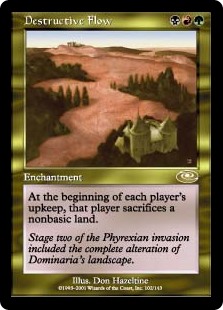Magic is nothing if not a series of attempts to outplay your opponent. Like a multifaceted Chess match, nearly every move made and tactic lobbied is done with the intent of stymieing your enemy and maintaining the upper hand. Sometimes the best path to victory is done by timing your moves correctly, lying in wait until the most opportune moment. Other times it’s by creating such overwhelming opposition or painful obstacles for your opponent that it serves as a deterrent. Still others it’s to move quickly to keep your enemy off balance and unable to adjust properly.
Regardless of the type of deck they use or style preferred, one of the best rules about how to win at Magic is the same that of the ancient battlefield: figure out your opponent’s biggest strength and remove it from the equation. Take away what makes them the most formidable.
If your enemy is really fast, try to slow them down. If they’re too strong to face head on, try to split their forces. If they’re going to lob arrows, ensure that your soldiers are properly defended. That sort of thing.
From an EDH perspective, that means attempting to nullify the various ways a deck is gains the upper hand on its competition. If a deck likes to routinely search for cards, for instance, you could use abilities that prevent or punish tutoring. If it relies predominantly on swarming with a horde of creatures, you can make it prohibitive to attack or even keep creatures on the battlefield.
In many EDH metas, one of the most common things you see, especially as players become more accustomed to making their own decks, is heavily modified mana bases. It’s fairly uncommon for Commander decks to run solely on basic land alone, whether it’s because you’re attempting to smooth out access to specific colors via mana fixing, thinning the deck slightly due to land fetching, or taking advantage of the ever growing genre of utility lands boasting powerful abilities. Some players take so much advantage of nonbasic lands that they greatly outnumber the deck’s amount of basic land, giving them a distinct land-based advantage – even if it’s an advantage not nearly as overt as other card types.
In most cases players tend to counteract this by using spot removal on the individual lands being the most problematic, as heavy-handed solutions such as Ruination aren’t overly beloved.
Still, if nonbasic land abuses is what you’re attempting to stop, there certainly are options that exist somewhere in the middle between individual destruction and mass land wipes. Options such as this week’s pick.
Today we have: Destructive Flow

Name: Destructive Flow
Edition: Planeshift
Rarity: Rare
Focus: Land Destruction
Highlights: Destructive Flow requires no elaborate explanation as to its use or its benefits; the card is highly self-explanatory. With this enchantment on the battlefield, you’re simultaneously slowing down and punishing players who rely extensively on nonbasic lands for one reason or another. Unlike spell-based cards with similar effects, this card continues to stick around for quite some time and can be more effective in some ways at hampering decks with heavy use of nonbasic lands, even if it doesn’t pack the same immediate punch as a Ruination, Wave of Vitriol, or From the Ashes.
That said, Destructive Flow does come with a pair of two minor drawbacks, though neither of which is terribly distressing. The first is the card’s tricolor nature. While the card is absurdly cheap in its casting cost at a mere three mana, it does require three different colors to cast, limiting the number of decks it can be used in. If your deck colors can swing it though, and you yourself aren’t running excessive amounts of nonbasics, this card can be slotted into a deck with zero effort.
The larger issue is that it’s indiscriminate land destruction, which doesn’t always go over incredibly well with many groups. It’s certainly not as bad as big sweepers, but its slow drip style of destruction may not make it an incredibly beloved enchantment either. So don’t expect a red carpet reception.
Yet because it often disproportionately affects players with fancier decks and more expensive cards, it’s also possible that because of this it won’t foster so much threat at the table that it will be a high target for spot enchantment removal in its own right. Because of that, this enchantment tends to have more longevity than it may first seem at first impression.
Moreover, because it’s being used in decks of at least three colors, it is possible to run into deckbuilding decisions that will have to be made with regards to how much of your own nonbasic land you wish to run. Decks of 3+ colors often rely on a lot of mana fixing, so you’ll want to be wary of not hamstringing yourself while attempting to undermine your opponent.
Which, of course, you don’t want to happen. A good tactician wants to take advantage of your enemy’s mistakes, not match them with some of their own.
Keep an eye out for us to be regularly featuring other more accessible-but-worth-it Commander cards going forward. In the meantime, we’ll keep the light on for you.
![]()
You can discuss this article over on our social media!
Do you have a particular Commander card to suggest for us to shine a future Spotlight on? You can send suggestions to ryan@cardboardrepublic.com
